Features
Return to Ukraine: searching out the Rosner family past
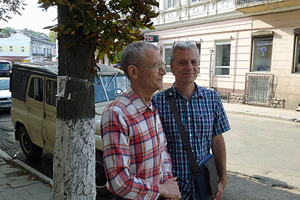
Introduction: Not too long ago we were contacted by former CBC Manitoba managing editor Cecil Rosner, who asked us whether we’d be interested in publishing a story about a trip he took in 2012 to visit the area in Ukraine where both his parents were born. Although it’s been 10 years since Cecil visited Ukraine, given the current situation in that country we thought it timely to get a sense of what life was like in Ukraine prior to the Russian invasion.
By CECIL ROSNER ““Oi — look at the way the schlemiel drives.”
We are bouncing along the potholed roads of Western Ukraine, heading from Lviv to my mother’s hometown of Buczacz. Our driver and guide isn’t Jewish, but that doesn’t stop him from endlessly whistling Fiddler on the Roof tunes and inserting Yiddishisms into every second phrase.
“These guys are all ganefs (thieves),” he says of the policemen we pass, as he forms his thumb and forefinger into a pistol and slowly pulls the trigger. Alex doesn’t like the speed traps the highway patrols set up, and he appreciates oncoming drivers signalling him to beware of cops just beyond the next hill. It’s an important issue for our driver, who crisscrosses Ukraine’s roads all year-long, ferrying tourists to distant towns and villages in search of their Jewish ancestors.
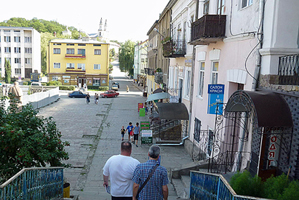
For Alex, who holds a history degree and is an expert at tracing genealogical roots, it’s an occupation he never dreamed he would have. But in the chaos of the Soviet Union’s collapse, when jobs were evaporating and everyone was trying to reimagine their lives, it seemed like a useful niche to pursue – especially as foreigners were finally trying to discover exactly what had happened to their relatives during the Second World War.
That’s why I’m here too, along with my wife and a cousin. Both of my parents were born in the region, and both were here when the Nazis occupied the area in 1941. In different improbable and miraculous ways, they both survived the war and emigrated to Canada. But every single other family member was shot, gassed, beaten or starved to death by the Nazis and their collaborators. We came here to see what traces of their lives remained.
It seemed logical to make our first stop the local museum, right across from the old city hall. Buczacz is little more than a village, with about 13,000 people. In the early part of the 19th century, Jews made up two-thirds of the population. While that number ebbed and flowed over the years, Jews were still in the majority when the Nazi occupation began. But that would have been difficult to discern in the museum.
In all the display cases, and in the colourful photo album that the town produces, there is no specific mention of a Jewish population. There is scarcely any reference to the Second World War, except for a notation that the town “was released from German invaders and captured by the Soviet Union.” Wouldn’t a town’s museum want to address what became of the majority of the population? What happened to thousands of farmers, shop owners, tailors, tinsmiths, doctors, lawyers and politicians? Doesn’t the mass roundup and extermination of most people in town even rate a mention?
The only hint of any Jewish presence came in the form of artifacts from the life of Shmuel Agnon, a Jewish writer born in Buczacz who won the Nobel Prize for literature. But the entire fate of the people Agnon wrote about had been erased.
Alex had little luck getting the museum’s employee to throw any light on what the town was like in the immediate pre-war period. She genuinely seemed not to know. But there were a few things I already knew.
My mother, Mina, had been born here in 1913, and her family owned a wholesale distribution company. They carbonated water and stored it in big, forty-litre copper cylinders, shipping them along with ice to shops throughout the area. When she was 25, she married my father, Michael Rosner, who came from nearby Kolomaya. In 1939, they opened a small retail store on the main town square, probably within metres of the present-day museum.
When the war broke out in September 1939, there was a reprieve. The region came under the control of the Soviets, and Jews were under no immediate threat. All that changed when Hitler marched eastward in 1941. My father was conscripted by the retreating Soviets, and my mother was trapped behind Nazi lines for the remainder of the war.
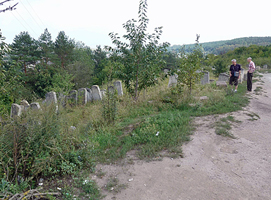
For the next three years, every member of my mother’s family – her parents, five brothers and sisters, aunts and uncles and cousins – were dragged from their hiding places, bludgeoned or shot, or sent off to be executed. They were all dumped into unmarked graves. My parents’ first-born child – my brother – also fell victim, dying at the age of three in 1942.
My mother’s survival defied any normal odds. She fled from one hiding place to another, escaping just in time to avoid capture. She spent 11 months in the attic of a Polish family along with five other Jews. She took an assumed name and boldly convinced the Nazis she was Christian. Finally, after Buczacz was liberated, she re-united with my father and they came to Canada to start anew in 1948.
I had been to Buczacz once before, with my mother, in 1990. We came with a documentary crew to record her first visit back home since the war. It was an emotional trip and a difficult one for both of us. But we learned very little of the actual events that had transpired in the town, or the exact locations where they happened. That’s why, nearly 15 years after my mother’s death, I was returning for a second time.
I convinced Alex that our best strategy on this trip would be to find older people and ask them what they knew about the 30s and 40s. Alex seemed skeptical. For one thing, the war had begun more than 70 years ago, so it was unlikely there would be any useful first-hand witnesses at hand. And there was also the collective amnesia that pertained to inconvenient truths.
After all, a segment of the population had actively collaborated with Hitler. They were instrumental in helping identify and round up the Jews, the Communists, and all the other elements the Nazis wanted to destroy. Some might still be living in Buczacz and surrounding areas. Their children and grandchildren almost certainly are here.
The museum’s employee finally gives us a sliver of hope. There is someone in town we should visit – someone who knows the history and might be able to help us. His name is Mykola.
We drive for a few minutes and stop at Mykola’s house. I am expecting to find an elderly man who may have been a teenager during the war. Instead, we come upon a 40-something man in sweatpants and a Maple Leafs T-shirt. He is clutching a handful of papers and photographs. One of them shows a photo of Buczacz’s surviving Jews standing beside a memorial gravestone in 1944. Out of the original population of 10,000, no more than 100 survived. One of the people in the photo is my mother.
Mykola has taken an interest in wartime history, and now helps visiting tourists locate family remnants. He has a variety of interesting documents, including a map of pre-war street names, and a mid-19th century register of townsfolk. It turns out that he knows about some of the Jewish families that lived in Buczacz during the war – a handful of them have returned over the years, and he has helped them find their old homes and landmarks.
We ask Mykola if he could help solve a puzzle my mother and I couldn’t figure out on our previous trip. Her family had lived on a street called Zeblickevicie, which had changed names several times after the war. From her description, though, we knew it was beside a stream that ran into the Strypa River, a subsidiary of the Dniester.
We pile into the car along with Mykola and he directs us to the location. The stream had been covered over, except at the point where it emptied into the Strypa. Though the original home was no longer there, he shows us the exact location where my mother’s family had lived. I saw the idyllic surroundings, the lush vegetation around the quiet river, and for the first time I had an inkling of the peaceful life my mother experienced before the war changed everything.
While we were all walking along the old Zeblickevicie street, Mykola bumps into a friend and exchanges a few words with him. As we walk on, the friend stops my wife, Harriet, and our cousin Nina and says: “Mina Rosner – I am a Witness.” That is the name of my mother’s book. Alex is impatient. He had rich experience of locals trying to pester visitors, and he was eager to move us all along. But Harriet and Nina persist. It turns out the man on our chance encounter knows all about my mother’s story, and offers to take us on a tour of where she lived, where she went to school, where she hid during the war, and where her family members were killed.
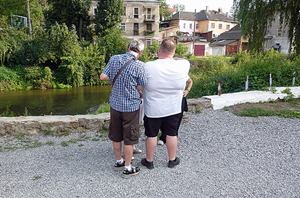
Over the next 24 hours, Alex grudgingly admits he was wrong. Our serendipitous encounter has linked us up with Jura, a 60-year-old retired computer technician, astrologist and local historian. He knows my mother’s exact birthdate, and, it appears, everyone else’s in town. He has a photocopied version of my mother’s book, and he has pieced together her recollections with precise locations of many of the events she describes. If photographic memories actually exist, we figure he has one. He is a visiting tourist’s dream come true, and Alex has to take a back seat while Jura takes us on a remarkable tour of my mother’s life.
The first stop is just around the corner, on a street that used to be called Chechego Maya. I remember it from my mother’s stories, but we could never pinpoint it on our previous trip. Jura shows us the building where my mother’s sister and her husband ran a hardware shop. He knows the address because it’s listed in trade publications of the era. Though my mother’s original house and her parents’ store no longer existed, I finally had an authentic touchstone of some of her family’s life at the time.
Jura takes us to the pre-war building on Kolejowa Street that served as the cheder, the religious school, where Jewish kids studied. We visit the girls’ school and middle school where my mother was a student, and walk into Buczacz’s Sokol theatre, where she watched dramatic performances and movies as a teenager. A group of children is rehearsing a musical concert on stage, and I can imagine my mother sitting in the auditorium with her brothers and sisters and friends.
Just down the road, near an orchard, Jura shows us the garden of a long-ago demolished home where my mother hid during one of the Nazi aktions, or periodic killing sprees. A bunker had been constructed in the cellar, and this helped shield her and other Jews from capture. The Nazis conducted four major aktions during their occupation of Buczacz before declaring the town Judenrein, or completely free of Jews. But the declaration turned out to be false. My mother, along with dozens of others, managed to survive with the aid of courageous gentile families who risked their safety to shelter them.
In the middle of our travels, Jura pulls out a sheet of typewritten names – people who had served as policemen, gendarmes and SS officers during the war. I recognize some of the names. Some of the Nazi war criminals and their collaborators have been brought to justice, but the vast majority remain undetected and untried for their crimes.
We go to the Jewish cemetery, where many of the town’s Jews – including my mother’s parents – were taken to be executed. The place is untended and overgrown, a jumble of brush and junk, with headstones in various states of disrepair. We find my great-grandmother’s grave. It’s significant, because two plots over my mother buried her first-born child, Isaac, in an unmarked plot. I clear away the branches and debris from the group of headstones in the area to get a better view. I bend down and touch the ground where the brother I never met is buried. Exactly 70 years later, someone has come back to this place to remember.
Jura takes me down a path through brambles to a spot where survivors had erected a memorial to the war’s victims. The place is overgrown with trees and bushes now, but he says there was nothing here before the war. The marker no longer survives, and even if it did, it’s unlikely anyone would be able to find it without an expert guide.
Our next stop is Fedor Hill, another killing ground where thousands perished. It’s difficult to see traces of anything here, but Jura once again guides us to a marker commemorating the killing of 450 people during the early days of slaughter in 1941. It had been erected by a survivor’s family well after the war.
A far more prominent memorial on Fedor Hill is dedicated to the UPA, the Ukrainian Insurgent Army, the military wing of a movement that initially collaborated with the Nazis in hopes of winning an independent homeland. In fact, throughout our travels in Western Ukraine, there were numerous new memorials to Ukrainian nationalist fighters in places where it might have been logical to place markers noting the victims of the Nazi era. We saw this on the side of a synagogue in Ivano-Frankivsk, near the Jewish ghetto entrance in Lvov, and many other places. In my father’s hometown of Kolomyia, it was a similar story — no mention of Jews or Nazi victims in the local museum, no remnants of the huge Jewish population, and a patriotic memorial to Ukrainian nationalist figures on the site of a former synagogue. In the re-written history of today, the UPA and its related Organization of Ukrainian Nationalists are presented as groups that fought both Soviets and Nazis; no mention is made of the collaboration in 1941 that led to so much destruction during the war.
Throughout our trip to Ukraine, we were reminded of the upcoming election campaign and the ever-present imagery of Ukrainian nationalism, especially in the Western part of the country. In a land that was exercising its brand of democratic activity, we had to wonder how thoroughly the country had come to grips with its recent history. Many countries are wrestling with related questions, trying to reconcile horrendous events of the past with a way forward. But as in any process or truth and reconciliation, there needs to be an initial recognition of what took place. Erasing and denying the past is rarely the path to building a healthy future.
At the end of our tour in Buczacz, Jura wanted to know the exact date of my mother’s death. He also was interested in our birthdates and any other information he could glean from us. In a country that chooses to forget so much, he was something of an anomaly.
Features
Is This the End of Jewish Life in Western Countries?

By HENRY SREBRNIK “Globalize the Intifada” has been the chant echoing through streets since October 7th, 2023. It was never a metaphor, and we now see the gruesome results across the western world, from Australia to Canada: the rise of groups of large, active networks of Islamist and anti-Zionist organizations.
Jews in the West are discovering that the nations they defended, enriched, and profoundly shaped have become increasingly inhospitable. After the Holocaust, explicit Jew-hatred became unfashionable in polite society, but the impulse never disappeared. The workaround was simple: separate Zionism from Judaism in name, then recycle every old anti-Jewish trope and pin it on “the Zionists.”
We have seen the full legitimization of genocidal anti-Zionism and its enthusiastic adoption by large segments of the public. The protests themselves, as they began immediately on October 7th, were celebrations of the Hamas massacres. The encampments, the building occupations, the harassment campaigns against Jewish students, the open calls for intifada, the attacks on Jews and Jewish places have become our new norm. History shows us that antisemitism does not respond to reason, incentive or the honest appeals of the Jewish community.
Outside the United States, there is no Western political establishment with either the will or the capability to address this problem, let alone reverse its growth. I’m sorry to say this, but the future of Western Europe, Canada, Australia, and New Zealand is likely to be increasingly Jew-free.
Today, police stand and watch mobs chant for Israel’s destruction, call for the genocide of its people, harass visibly Jewish citizens, and drive antisemitic intimidation deep into urban life. They now believe their job is to enforce the law only if it does not risk upsetting violent constituencies. This makes Jews expendable, because defending them risks confrontation. This was very clear in the Bondi Beach massacre.
Jews are again donning caps instead of kippot, dressing generically with no cultural markers, and avoiding even a tote bag with Hebrew on it. A corrosive creep toward informal segregation in retail and service sectors is occurring, as Jewish customers report being refused service. A mezuzah hanging from a rideshare mirror leads to cancellations. When Jews express frustration, they are accused of exaggeration or attempting to suppress criticism of Israel. Jewish fear is not treated as a real problem.
“Jews Are Being Sent Back into Hiding,” the title of a Dec. 15 article in the New York Free Press by David Wolpe and Deborah Lipstadt, asserts that the attacks on Jews, including physical assaults, social media campaigns and, most tragically, the recent murders in Australia, are part of a purposive campaign designed to make Jews think twice about gathering with other Jews, entering a synagogue, going to kosher restaurants, putting a mezuzah on the doorpost of their apartments or dorm rooms, or wearing a Jewish star around their necks.
“We know of no one who would consider giving a niece, nephew, grandchild, or young friend a Jewish star without first asking permission of their parents,” they write. The unspoken, and sometimes spoken, question is: “Might wearing a star endanger your child’s well-being?”
Recently, a prominent American rabbi was entering a Target store in Chicago with her grandson, whom she had picked up from his Jewish day school. As they walked into the store the 10-year-old reached up and automatically took off his kippah and put it in his pocket. Seeing his grandmother’s quizzical look, he explained: “Mommy wants me to do that.”
Borrowing a phrase from another form of bigotry, they contend that Jews are going “back into the closet.” No public celebration of Hanukkah took place in 2025 without a significant police presence. Some people chose to stay home.
Lipstadt and Wolpe know whereof they speak. They are respectively a professor of history and Holocaust studies who served as the Biden administration’s ambassador tasked with combating antisemitism, the other a rabbi who travels to Jewish communities throughout the world, and who served on Harvard’s antisemitism task force in the aftermath of the October 7, 2023 pogrom.
What the world has seen over the past two years is a continual, often systematic attempt to terrorize Jews. When political leaders fail to condemn rather than merely “discourage” chants of “globalize the intifada,” we are seeding the ground for massacres like the Hannukah one in Sydney.
If each Jewish holiday will now be seen by antisemites as an opportunity for terror, then the prognosis for diaspora Jewry is bleak. There will be fewer public events, more alarms, more bag checks at doors; there will have to be more security and more police. Unless things change, Jewish life in the diaspora will become more sealed off from the larger society.
Why has this failure come about? Confronting antisemitism, stopping the mobs, challenging the activists, and disciplining antisemitic bureaucrats all carry electoral risk for politicians; Jews are demographically irrelevant, especially compared with Muslim voters, with the U.S. being the only partial exception.
There are those who suggest Jews stop donating funds to educational and other institutions that have turned against us. At this point, I doubt very much that withdrawing dollars will have an impact. For every dollar withdrawn, there will be 100 from Qatar and other sources in its place.
Throughout history, the way a society treats its Jews predicts its future with unerring accuracy. If Jews leave, it will be because a civilization that will not defend its Jews will also defend next to nothing and may itself not survive.
Henry Srebrnik is a professor of political science at the University of Prince Edward Island
Features
Canadian Travel Trends 2025 and the Forecast for 2026

Canadians planning to travel in 2026 should keep an eye on shifting trends and learn what’s coming their way in the new year.
Canadian travel has seen a fair amount of change and instability over the last few years, thanks mostly to the country’s southern neighbours. In 2025, and likely into 2026, travel trends in the Great White North have stabilized significantly, with more Canadians than ever choosing to travel within their own borders. And with 2026 nipping at our heels, let’s take a look at what trends in 2025 have been the most prevalent and how these will shape travellers’ decisions and travel plans in the new year.
Canadian Travel in 2025
Thanks to many factors, including politics, inflation, and airline competition, the majority of travellers opted to explore their own country rather than go abroad in 2025. More local travel money is remaining within the local economy, further bolstering it and making it an even more attractive travel choice. Thanks to the accessibility of private jet charter travel across Canada, luxury local travel has increased as well, with more people looking to immerse themselves in luxury from the start of their journey to the end. When travelling abroad, the U.S. is now the least favoured destination for most Canadian travellers, but Europe saw a significant increase in interest as 2025 progressed.
As local Canadian travel increased this year, it brought with it a drive for local tourists to find their own “Secret Canada” destinations. Far more “off the beaten path” trips were taken, resulting in more travel spending going to smaller or more boutique destinations rather than big city experiences. In 2025, travellers have sought out the wonderful diversity in destinations and landscapes, allowing themselves to access more grounded and authentically Canadian experiences.
Canada’s Government has also encouraged and benefited from local tourism, with initiatives like the Canada Strong Pass offering extra benefits. Initially implemented in the summer, but reintroduced from December 12, 2025, until January 15, 2026, this is a ticket to enjoying the richness of their own culture (iconic natural destinations, museums, train trips) at a discounted rate or even in some cases free of charge.
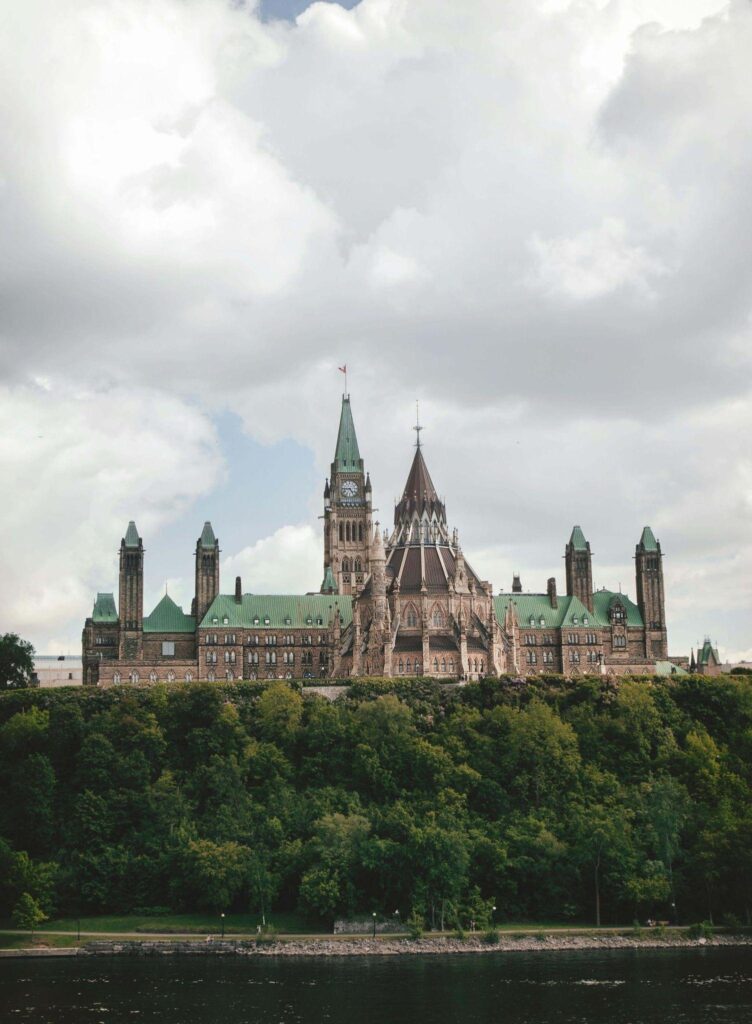
In the second quarter of 2025, locals took a total of 90.6 million trips that included at least some time spent travelling domestically, which indicated a rise of 10.9% on a year-over-year basis. Of these trips, 58.6 million were day trip experiences (an increase of 12.4%), and 32.0 million were overnight trips or longer (an increase of 8.4%).
Between April and June of this year, Canadian residents spent $20.3 billion on local tourism, which represented a 13.5% year-over-year increase. When undertaking day trips, Canadians spent approximately $101 per visit. On overnight trips, locals spent around $449 per trip, with an average trip length of 2.6 nights. The Great White North is clearly holding its own, and then some, in the international travel market.
Canadian Travel in 2026
As we move towards 2026, many trends from 2025 will remain the standard, but some will evolve to fit changing demands. Across the board, though, the outlook for the coming year is that Canadian travel will become a far more personal thing, with trips being customized to fit travellers’ requirements and desires more closely than ever before. From choosing a hotel that they feel smacks of a beloved destination in their favourite novel, to taking a trip to a destination just to try a snack that’s famously made there and only there, travel is stretching and shifting for the traveller rather than the other way around.
Here are some slightly more specific predictions for the coming year based on the answers of polled Canadians.

- One Gen Z-led trend is the idea of “glowmad travel”. Beauty and skincare are now influencing the places that Gen Z travels, and their trips are far more likely to include visits to skincare and beauty destinations like spas and luxury stores.
- Gen Z adults are helping to drive another trend: family travel as a way to save money. 345 of Gen Z adults polled say that they would take this route.
- More than 70% of Canadians are considering some sort of mountainous getaway in 2026, specifically in summer or autumn.
- 48% of polled Canadians say they would book or consider a destination thanks to the influence of literature.
- More travellers than ever are choosing their destinations based on the accommodations available. 44% of polled travellers say that in 2026, accommodation and what it can offer comes first, and the surrounding destination comes second.
The World Is Your Nova Scotia Lobster Roll
Choose something a little different when you vacation this year. Oysters are great, but a Nova Scotia lobster roll might be more to your taste! Canadians know good travel, so take a maple leaf out of their book and experience something new this year.
Features
Fake IDs and Underage Bettors: The Growing Problem for Sportsbooks
The expansion of legalized sports betting worldwide has resulted in sportsbooks grappling with a problem that they can no longer overlook: the increase in underage individuals using counterfeit identification to place bets. As more and more ways to bet through mobile apps and online sign-ups emerge, minors who are set on their goal are inventing ways to get around age limits. The emergence of this trend is a breach of the law and morality; however, it is also an enormous problem that threatens the very existence of the platforms, which are forced to rigorously obey the regulations .
Why Fake IDs Are Becoming More Sophisticated
Conventional fakes used to be quite simple to recognize—low-quality printing, different fonts for the text, and inconsistent holograms would make them not very reliable for any kind of verification. But counterfeit documents have changed significantly over time. Nowadays, fakes are made better with the help of printing technology and software, and they can even copy barcodes and other scannable features, so their IDs look almost real.
This fact complicates things significantly for sportsbooks, especially those operating online. Most of the time, automated identity verification systems capture a user’s photo and perform basic data matching. In cases where a very good fake ID is used by a teenager who looks older, some systems cannot recognize the trick. Therefore, young bettors have found ways to be able to place wagers through these loopholes.
The Influence of Social Pressure and Online Culture
Social media is a major factor in the increase in risky behavior that minors are engaging in. On various platforms such as Instagram, TikTok, and Reddit, teenagers come across betting slips, parlay wins, and big-payout screenshots that are shared, most probably, by other users. The glamorization of sports betting is leading young people to copy the behavior of influencers, older friends, or even celebrities, as they think that it is the right thing to do.
The competitiveness usually associated with sports is one of the reasons some minors decide to bet on sports. For many, betting becomes another way to engage as a fan—by predicting outcomes, challenging friends, and experiencing the same excitement that adult fans enjoy. Unfortunately, only a small number of minors fully understand the financial risks involved, making them more vulnerable to developing harmful patterns that could continue into adulthood. This is why choosing the most responsible sportsbook, which you can discover more here, is essential. Such platforms provide guidance, enforce safe practices, and ensure regulated play, allowing fans to engage with sports betting in a more informed, secure, and controlled manner.
Sportsbooks Facing Regulatory Pressure
The sportsbooks are being given the task of more closely monitoring and preventing minors from betting on their platforms. If they fail, harsh penalties are possible, including severe fines, loss of a gambling license, and negative publicity that undermines a brand’s trustworthiness. As a result, it is becoming increasingly difficult for people to verify their identities, although this also inconveniences those who are, in fact, legitimate users.
Sportsbooks have to decide between two options that are in conflict with each other: on the one hand, they have to keep the registration process as simple as possible, and on the other hand, they have to carry out age verification in a very thorough manner. The work of balancing is tough, and the underage gamblers are trying all methods to find a way out.
The Rise of Identity Fraud Services
An alarming trend is the emergence of online vendors who openly advertise fake IDs and identity documents. These vendors often claim their products can pass standard sportsbook checks. Some even tailor IDs to specific regions, knowing that certain provinces, states, or countries use verification systems that rely heavily on image comparison rather than live validation.
The availability of these fraudulent services not only empowers minors but also exposes sportsbooks to risks related to stolen identities, money laundering flags, and fraudulent accounts that may later become legal liabilities.
The Consequences for Underage Bettors
While a minor might think that gambling is just a bit of fun without any harm, the outcome can be quite serious. If there is a catching, accounts are closed right away, winnings are confiscated, and parents or guardians, in some cases, are made legally liable for any financial disagreements. Besides that, the risk of developing a gambling problem in the future increases with early exposure to gambling, especially since teenagers are more impulsive and less capable of handling financial risks.
The majority of minors are not aware that sportsbooks keep very detailed records of their activities, including device information and IP addresses. In case a fake ID works one time, using it multiple times will definitely lead to getting caught.
A Growing Problem That Requires Joint Action
Fake IDs and underage betting are issues that have become a major challenge in the industry, and no single stakeholder can solve these problems on their own. Sportsbooks need to enhance their identity verifications, regulators should get prepared for new types of fraud, technology providers have to come up with new solutions more quickly, and parents should always be aware of what their children are doing online. The industry’s rapid development is making this problem more and more urgent because the number of minors trying to get around the safety measures is increasing.
Sports betting can serve as a fun and legal form of entertainment for adults, but the need to protect the youth is what defines the industry and ensures its survival in the long run. As the quality of fake IDs keeps improving and the online culture is more and more inclined to consider betting as a normal activity, sportsbooks must ensure that underage users do not have access and that the environment is safe for all users. They need to do this now more than ever.

